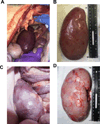Role of Intrinsic (Graft) Versus Extrinsic (Host) Factors in the Growth of Transplanted Organs Following Allogeneic and Xenogeneic Transplantation
- PMID: 28117931
- PMCID: PMC5489354
- DOI: 10.1111/ajt.14210
Role of Intrinsic (Graft) Versus Extrinsic (Host) Factors in the Growth of Transplanted Organs Following Allogeneic and Xenogeneic Transplantation
Abstract
In our studies of life-supporting α-1,3-galactocyltransferase knockout (GalT-KO) pig-to-baboon kidneys, we found that some recipients developed increased serum creatinine with growth of the grafts, without histological or immunological evidence of rejection. We hypothesized that the rapid growth of orthotopic pig grafts in smaller baboon recipients may have led to deterioration of organ function. To test this hypothesis for both kidneys and lungs, we assessed whether the growth of outbred (Yorkshire) organ transplants in miniature swine was regulated by intrinsic (graft) or extrinsic (host environment) factors. Yorkshire kidneys exhibited persistent growth in miniature swine, reaching 3.7 times their initial volume over 3 mo versus 1.2 times for miniature swine kidneys over the same time period. Similar rapid early growth of lung allografts was observed and, in this case, led to organ dysfunction. For xenograft kidneys, a review of our results suggests that there is a threshold for kidney graft volume of 25 cm3 /kg of recipient body weight at which cortical ischemia is induced in transplanted GalT-KO kidneys in baboons. These results suggest that intrinsic factors are responsible, at least in part, for growth of donor organs and that this property should be taken into consideration for growth-curve-mismatched transplants, especially for life-supporting organs transplanted into a limited recipient space.
Keywords: growth and development; kidney (allograft) function/dysfunction; kidney transplantation/nephrology; lung failure/injury; lung transplantation/pulmonology; organ allocation; translational research/science; xenotransplantation.
© 2017 The American Society of Transplantation and the American Society of Transplant Surgeons.
Conflict of interest statement
Disclosure
The authors of this manuscript have no conflicts of interest to disclose as described by the American Journal of Transplantation.
Figures









Similar articles
-
Role of Intrinsic Factors in the Growth of Transplanted Organs Following Transplantation.J Immunobiol. 2017 Jun;2(2):122. doi: 10.4172/2476-1966.1000122. Epub 2017 May 2. J Immunobiol. 2017. PMID: 28725880 Free PMC article.
-
Increased levels of anti-non-Gal IgG following pig-to-baboon bone marrow transplantation correlate with failure of engraftment.Xenotransplantation. 2013 Nov-Dec;20(6):458-68. doi: 10.1111/xen.12065. Epub 2013 Oct 29. Xenotransplantation. 2013. PMID: 24289469 Free PMC article.
-
Results of gal-knockout porcine thymokidney xenografts.Am J Transplant. 2009 Dec;9(12):2669-78. doi: 10.1111/j.1600-6143.2009.02849.x. Epub 2009 Oct 21. Am J Transplant. 2009. PMID: 19845583 Free PMC article.
-
Indicators of impending pig kidney and heart xenograft failure: Relevance to clinical organ xenotransplantation - Review article.Int J Surg. 2019 Oct;70:84-91. doi: 10.1016/j.ijsu.2019.08.024. Epub 2019 Aug 21. Int J Surg. 2019. PMID: 31445094 Review.
-
Histopathology of xenografts in pig to non-human primate discordant xenotransplantation.Clin Transplant. 2010 Jul;24 Suppl 22:11-5. doi: 10.1111/j.1399-0012.2010.01270.x. Clin Transplant. 2010. PMID: 20590687 Review.
Cited by
-
The potential of genetically engineered pig heart transplantation in infants with complex congenital heart disease.Pediatr Transplant. 2022 Aug;26(5):e14260. doi: 10.1111/petr.14260. Epub 2022 Mar 1. Pediatr Transplant. 2022. PMID: 35233893 Free PMC article. Review.
-
High mobility group A2 (HMGA2) deficiency in pigs leads to dwarfism, abnormal fetal resource allocation, and cryptorchidism.Proc Natl Acad Sci U S A. 2018 May 22;115(21):5420-5425. doi: 10.1073/pnas.1721630115. Epub 2018 May 7. Proc Natl Acad Sci U S A. 2018. PMID: 29735702 Free PMC article.
-
Remaining Physiological Barriers in Porcine Kidney Xenotransplantation: Potential Pathways behind Proteinuria as well as Factors Related to Growth Discrepancies following Pig-to-Kidney Xenotransplantation.J Immunol Res. 2018 Mar 4;2018:6413012. doi: 10.1155/2018/6413012. eCollection 2018. J Immunol Res. 2018. PMID: 29687010 Free PMC article. Review.
-
[Xenotransplantation of solid organs].Chirurgie (Heidelb). 2024 Aug;95(8):603-609. doi: 10.1007/s00104-024-02093-y. Epub 2024 May 15. Chirurgie (Heidelb). 2024. PMID: 38748210 Free PMC article. Review. German.
-
Xenotransplantation: Where Are We with Potential Kidney Recipients? Recent Progress and Potential Future Clinical Trials.Curr Transplant Rep. 2017 Jun;4(2):101-109. doi: 10.1007/s40472-017-0149-6. Epub 2017 May 8. Curr Transplant Rep. 2017. PMID: 28989853 Free PMC article.
References
-
- Klassen DK, Edwards LB, Stewart DE, Glazier AK, Orlowski JP, Berg CL. The OPTN Deceased Donor Potential Study: Implications for Policy and Practice. American journal of transplantation : official journal of the American Society of Transplantation and the American Society of Transplant Surgeons. 2016;16(6):1707–1714. - PubMed
-
- Sachs DH. The pig as a xenograft donor. Pathologie-biologie. 1994;42(3):217–219. - PubMed
-
- Sato M, Kagoshima A, Saitoh I, Inada E, Miyoshi K, Ohtsuka M, et al. Generation of alpha-1,3-Galactosyltransferase-Deficient Porcine Embryonic Fibroblasts by CRISPR/Cas9-Mediated Knock-in of a Small Mutated Sequence and a Targeted Toxin-Based Selection System. Reproduction in domestic animals = Zuchthygiene. 2015;50(5):872–880. - PubMed
Publication types
MeSH terms
Substances
Grants and funding
LinkOut - more resources
Full Text Sources
Other Literature Sources
Medical
Research Materials

